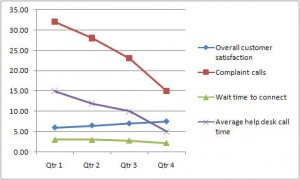The MLS industry is in an extremely tenuous position today, feeling pressures from 3rd party vendors, state associations, neighboring MLSs and declining membership. Like any business channel, multiple entities in the MLS world are competing for a finite number of customers and business space. To make things even more difficult, a percentage of MLS leadership changes from year to year with election of new officers and directors. MLS staff has to adjust to different leadership styles while often having to re-educate the new regime on where things stand. It can be a difficult scenario for staff and the elected leadership. How can an MLS establish continuity and transparency year to year more effectively? How does leadership insure that everyone on the MLS team knows what the goals are? How does leadership and staff know how they are doing against these goals at any given time?
Test your staff
If you want to see how effective your last strategic planning process was test your staff.
If you asked a staff member in your MLS what the top five goals for the organization are could they tell you? If you asked them how the MLS was doing in regards to these goals would they know? Is their answer opinion or fact? Would they be able to show objectively how their part of the team is doing? Do they clearly know what their specific objectives are today and for the year?
It has been our experience, when we talk to MLS staff prior to our strategic planning sessions, that if you talk to 10 different people and ask questons like these you will get many different opinions, some blank stares and some “I have no ideas”! So you have to wonder, if they can’t answer these questions what is the likelihood everyone is really on the same page working optimally toward the strategic goals of the MLS?
The good news is there are real tools that can help make this happen in your MLS!
One key to making that happen is moving beyond “strategic planning“, which most MLSs and boards do periodically, to something we call “strategic management”! What this boils down to is taking the goals and objectives identified during the strategic planning process and then creating executable and measurable plans that are used by the entire MLS team?
Benchmarking is one Key
It has been our experience that many MLSs often do not have specific benchmarks and metrics to actually track the progress of the priorities established by leadership during planning sessions. So knowing whether goals have been achieved, beyond obvious financial measurements, is often a “subjective” exercise. We believe the ending of any strategic planning session should always be the beginning of the strategic “management” process. That management process and execution of realistic plans is really what determines the ultimate value of the strategic session. At the end of a year after a successful planning session MLSs should be able to list out their strategic objectives and quantitatively show how they have performed relative to their goals?
For example, if an MLS has a goal to improve customer service, what does that really mean and how do you measure it? It might mean several things, including:
- Higher ratings on customer satisfaction surveys
- Shorter wait times for members when they call in for service
- Shorter call times when call the help desk
- Reduction in “complaint” calls
So for each goal identified during a strategic plan there should be a corresponding process applied to it that breaks it down into obtainable steps. Leaders are assigned to manage each objective. Team members know their specific responsibilities and goals. Necessary resources and conflicts are identified. Budget issues are addressed. As importantly, there should be metrics applied to it that show whether progress is being made or not.
Imagine the value to the Board of Directors if they could look at each of their objectives at their monthly meeting and get a snapshot of progress against goals, based on solid metrics, as illustrated below:

Supporting this high level chart would be all of the detailed analytics defined during the planning session. While this is a simple example, the key point is each of these items is specific and can be shown via a metric which leadership can then use to track progress.
Critical questions
Before you finalize your next plan, take a look at your goals and objectives and see if you can answer these questions first.
- Is the objective clear and understandable?
- Is it clear who is accountable to lead the initiative?
- Have you identified other resources needed?
- What are the budget requirements?
- What are the due dates?
- What other resources are required or impacted?
- What tools will leadership use to measure progress?
If you can, your leadership will be in a much better position to achieve their strategic objectives.
The Benefits
The benefits to taking a strategic management approach extend far beyond just tracking numbers up or down. Organizations that implement these systems now find they have tools they never had to quickly identify bottlenecks. They now have the ability to identify people on their team that are really contributing or those that may need assistance. Recognition and company wide insight provides motivation and job satisfaction. The transparency that these processes and tools create has the immediate impact of getting the entire organization on the same page. Everybody understands the objectives and goals of the Board and everybody has a clear understanding of the progress being made. Staff are rewarded for success. Accountability and transparency raise the bar for the entire organization which can only help any MLS in these competitive times.




